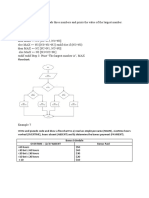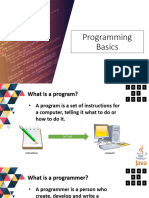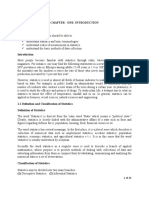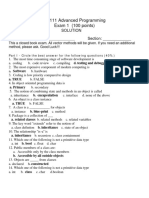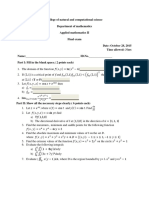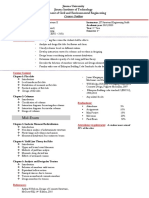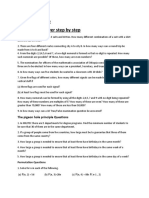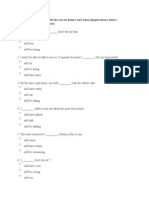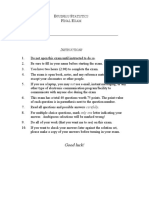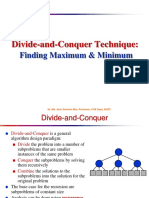Introduction to Flowcharts
1
Program Designing techniques
Pseudocode
Algorithm
Flowchart
2
Designing techniques
A typical programming task can be divided
into two phases:
Problem solving phase
produce an ordered sequence of steps that
describe solution of problem
this sequence of steps is called an algorithm
Implementation phase
implement the program in some programming
language
3
Steps in Problem Solving
First produce a general algorithm (one can use
pseudocode)
Refine the algorithm successively to get step
by step detailed algorithm that is very close to
a computer language.
Pseudocode is an artificial and informal
language that helps programmers develop
algorithms.
Pseudocode is very similar to everyday
English.
4
Pseudocode & Algorithm
Example 1: Write a pseudocode and an
algorithm to convert the length in feet to
inches.
5
Example 2
Pseudocode:
Input the length in feet
Calculate the length in inches by
multiplying length in feet with 12
Print length in inches.
6
Example 2
Algorithm
Step 1: Input L_ft
Step 2: L_inches L_ft x 12
Step 3: Print L_inches
7
The Flowchart
A schematic representation of a sequence of
operations, as in a manufacturing process or
computer program.
It is a graphic representation of how a process
works, showing, at a minimum, the sequence of
steps.
A flowchart consists of a sequence of instructions
linked together by arrows to show the order in
which the instructions must be carried out.
8
Cont…
Each instruction is put into a box. The
boxes are different shapes depending
upon what the instruction is.
Different symbols are used to draw each
type of flowchart.
9
Cont…
A Flowchart
shows logic of an algorithm
emphasizes individual steps and their
interconnections
e.g. control flow from one action to the next
10
Flowchart Symbols
Basic
Name Symbol Use in Flowchart
Oval Denotes the beginning or end of the program
Parallelogram Denotes an input operation
Rectangle Denotes a process to be carried out
e.g. addition, subtraction, division etc.
Diamond Denotes a decision (or branch) to be made.
The program should continue along one of
two routes. (e.g. IF/THEN/ELSE)
Hybrid Denotes an output operation
Flow line Denotes the direction of logic flow in the program
11
Example 2
Write an algorithm and draw a flowchart
to convert the length in feet to
centimeter.
Pseudocode:
Input the length in feet (Lft)
Calculate the length in cm (Lcm) by
multiplying LFT with 30
Print length in cm (LCM)
12
Example 2
Algorithm Flowchart
Step 1: Input L_ft START
Step 2: Lcm L_ft x 30 Input
L_ft
Step 3: Print L_cm
Lcm L_ft x 30
Print
L_cm
STOP
13
Example 3
Write an algorithm and draw a flowchart
that will read the two sides of a rectangle
and calculate its area.
Pseudocode
Input the width (W) and Length (L) of a
rectangle
Calculate the area (A) by multiplying L with W
Print A
14
Example 3
Algorithm START
Step 1: Input W,L Input
W, L
Step 2: AL x W
Step 3: Print A ALxW
Print
A
STOP
15
Example 4
Write an algorithm and draw a flowchart that
will calculate the roots of a quadratic
equation 2
ax bx c 0
2
Hint: d = sqrt ( b 4ac ), and the roots are:
x1 = (–b + d)/2a and x2 = (–b – d)/2a
16
Example 4
Pseudocode:
Input the coefficients (a, b, c) of the
quadratic equation
Calculate d
Calculate x1
Calculate x2
Print x1 and x2
17
Example 4
START
Algorithm:
Step 1: Input a, b, c Input
a, b, c
Step 2: d sqrt ( b b 4 a ) c
Step 3: x1 (–b + d) / (2 x a) d sqrt(b x b – 4 x a x c)
Step 4: x2 (–b – d) / (2 x a)
Step 5: Print x1, x2 x1 (–b + d) / (2 x a)
X2 (–b – d) / (2 x a)
Print
x1 ,x2
STOP
18
Decision Structures
The expression A>B is a logical expression
it describes a condition we want to test
if A>B is true (if A is greater than B) we take
the action on left
print the value of A
if A>B is false (if A is not greater than B) we
take the action on right
print the value of B
19
Decision Structures
Y is
N
A>B
Print A Print B
20
IF–THEN–ELSE STRUCTURE
The structure is as follows
If condition then
true alternative
else
false alternative
endif
21
IF–THEN–ELSE STRUCTURE
If A>B then
print A
else Y is
N
A>B
print B
endif Print A Print B
22
Relational Operators
Relational Operators
Operator Description
> Greater than
< Less than
= Equal to
Greater than or equal to
Less than or equal to
Not equal to
23
Example 5
Write an algorithm that reads two values, determines
the largest value and prints the largest value with an
identifying message.
ALGORITHM
Step 1: Input VALUE1, VALUE2
Step 2: if (VALUE1 > VALUE2) then
MAX VALUE1
else
MAX VALUE2
endif
Step 3: Print “The largest value is”, MAX
24
Example 5
START
Input
VALUE1,VALUE2
Y is N
VALUE1>VALUE2
MAX VALUE1 MAX VALUE2
Print
“The largest value is”, MAX
STOP 25
NESTED IFS
One of the alternatives within an IF–
THEN–ELSE statement
may involve further IF–THEN–ELSE
statement
26
Example 6
Write an algorithm that reads three
numbers and prints the value of the
largest number.
27
Example 6
Step 1: Input N1, N2, N3
Step 2: if (N1>N2) then
if (N1>N3) then
MAX N1 [N1>N2, N1>N3]
else
MAX N3 [N3>N1>N2]
endif
else
if (N2>N3) then
MAX N2 [N2>N1, N2>N3]
else
MAX N3 [N3>N2>N1]
endif
endif
Step 3: Print “The largest number is”, MAX
28
Example 6
Flowchart: Draw the flowchart of the
above Algorithm.
29
Flowchart
NO
30
Example 7
Write and algorithm and draw a
flowchart to read an employee name
(NAME), overtime hours worked
(OVERTIME), hours absent (ABSENT)
and determine the bonus payment
(PAYMENT).
31
Example 7
Bonus Schedule
OVERTIME – (2/3)*ABSENT Bonus Paid
>40 hours $50
>30 but 40 hours $40
>20 but 30 hours $30
>10 but 20 hours $20
10 hours $10
32
Algorithm
Step 1: Input NAME,OVERTIME,ABSENT
Step 2: if (OVERTIME–(2/3)*ABSENT > 40 ) then
PAYMENT 50
else if (OVERTIME–(2/3)*ABSENT > 30 &&
OVERTIME–(2/3)*ABSENT<= 40 ) then
PAYMENT 40
else if (OVERTIME–(2/3)*ABSENT > 20 &&
OVERTIME–(2/3)*ABSENT<= 30 ) then
PAYMENT 30
33
else if (OVERTIME–(2/3)*ABSENT > 10 &&
OVERTIME–(2/3)*ABSENT<= 20) then
PAYMENT 20
else
PAYMENT 10
endif
Step 3: Print “Bonus for”, NAME “is $”,
PAYMENT
34
Example 7
Flowchart: Draw the flowchart of the
above algorithm?
35
LOOPS
Computers are particularly well suited to
applications in which operations are
repeated many times.
If the same task is repeated over and
over again a loop can be used to reduce
program size and complexity
36
Example 8:
Flowchart for finding the sum of first five natural numbers
( i.e. 1,2,3,4,5):
37
Example 9
Flowchart to find the sum of first 50 natural numbers.
38
Example 10
Write down an algorithm and draw a
flowchart to find and print the largest of N (N
can be any number) numbers. (Assume N to
be 5 and the following set to be the numbers
{1 4 2 6 8 })
39
Algorithm:
Step 1: Input N
Step 2: Input Current
Step 3: Max Current
Step 4: Counter 1
Step 5: While (Counter < N)
Repeat steps 5 through 8
Step 6: Counter Counter + 1
Step 7: Input Next
Step 8: If (Next > Max) then
Max Next
endif
Step 9: Print Max
40
Flowchart
START
Input
N, Current
Max Current
Counter 1
N
Counter < N
Y
Print
Counter Counter +1 Max
Input
Next
STOP
N
Next >Max
Y
Max Next
41
END
42





